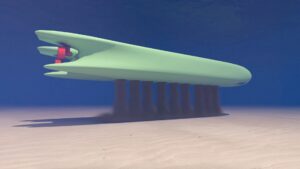Autonomy – A Giant Leap Towards Decarbonization
Reducing the carbon footprint of the global shipping industry and reaping the efficiency gains offered by autonomous vessels have been two of C-Job’s leading research priorities in recent years. Our initial investigations into autonomous shipping made us realize that it entails more than just autonomy, but also has enormous potential and represents huge breakthroughs in sustainability, safety, and cost reductions.
However, while others in the sector were working on adapting existing vessel types to make them autonomous using sensors and algorithms, we had other ideas. At C-Job we realized that in order to make use of the full potential of autonomous vessels, it would be necessary to start with a blank piece of paper. Only the total redesign of the vessels themselves from the keel up, including the way they operate and the systems they use, could deliver the outcomes that our industry needs. That said, the gradual introduction of autonomous systems on conventional vessels as part of the transition process will be an important feature of shipbuilding and conversion for the next decade or more.
Autonomous Underwater Maintenance Dredger (AUMD)
An example of total redesign is the development of the C-Job Autonomous Underwater Maintenance Dredger (AUMD) concept, which takes autonomous shipping to a whole new level. Not only is it autonomous, it is also a submarine. Revolutionary, but also logical. Submarines are far more efficient than conventional ships as they do not need to push through and over waves, and the energy requirements for dredging decrease the closer the dredge pump is to the seabed.
Using simulations that compared the AUMD design to an actual TSHD with the same dredging performance, it was discovered that not only was 55% less propulsion power needed, but also that 80% less dredging power was required with the vessel operating much closer to the seabed than its conventional counterpart.

Much of this gain is derived directly from this concept, including eliminating all the space and support systems previously required by onboard crew. This greatly simplifies the vessel compared to its crewed equivalent, resulting in smaller vessels that have the same capabilities while delivering significant reductions in build and operating costs. Moreover, this will enable the application of fully emission-free energy supply systems in a cost-effective manner.
C-Job’s research was presented in 2020 at the International Conference on Maritime Autonomous Surface Ships (ICMASS) in Trondheim, Norway. The reception to the presentation was very positive and resulted in C-Job being invited by a third party to develop the concept further. It was decided that the research would continue with another autonomous subsea dredging project, ALERD.
Positive results
With the research so promising, the decision was taken to develop the AUMD further as a proof of concept. The results so far include:
- A third-party life cycle assessment of the overall contribution to reducing harm to the environment confirmed that the overall cost of the environmental impact bof an AUMD versus a comparable TSHD would be reduced by at least 83%.
- Model testing produced many useful insights into how the dredged material entering the vessel would affect its stability, opening up further avenues for investigation.
- A simulation model was developed to explore operational costs relative to the dimensions of the vessel. This established that a battery-powered submarine dredger with a 2,500 m³ hopper capacity would be most cost-effective.
The AUMD was followed by a second project, in which we took part together with a group of relevant and passionate partners. This involved the development of a battery-powered autonomous guard vessel (AGV) concept design for use in ports and harbors. With the human element replaced by autonomous shipping solutions the result was again a compact, cost-effective, and sustainable solution.
What’s next?
The response to these innovations from dredging operators has been one of great interest, but there is much work still to be done before the marketplace is fully satisfied. Our research program continues to develop with the ALERD project, a new concept that takes the AUMD to the next level.
Despite the challenges, the transition to clean, autonomous shipping remains one of the great challenges of our time and C-Job is proud to be taking a leading role in designing transformative vessels that have the potential to deliver unprecedented gains in efficiency and sustainability.
